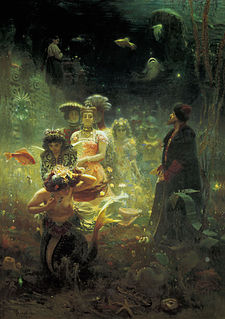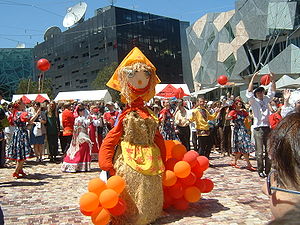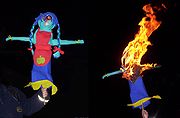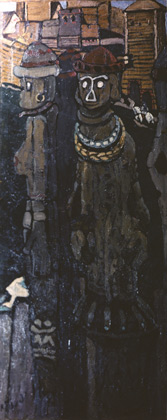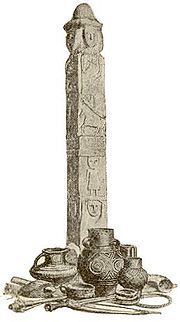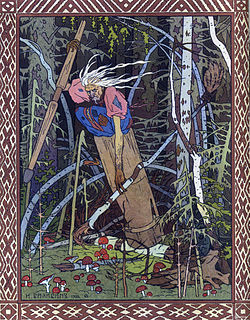
Slavic mythology
About this schools Wikipedia selection
SOS Children have produced a selection of wikipedia articles for schools since 2005. Visit the SOS Children website at http://www.soschildren.org/
Slavic mythology is the mythological aspect of the religion that was practised by the ancient Slavs. It evolved over more than 3,000 years. It is conjectured that some parts of it are from Neolithic or possibly even Mesolithic times. The religion possesses numerous common traits with other religions descended from the Proto-Indo-European religion.
Calendar and festivals
Slavic myths were cyclical, repeating every year over a series of festivities that followed changes of nature and seasons. Thus, to understand their mythology, it is important to understand their concept of calendar. On the basis of archeological and folklore remains, it is possible to reconstruct some elements of pre-Christian calendar, particularly major feastivals.
- The year was apparently lunar, and began on the first day of March, similar to other Indo-European cultures whose old calendar systems are better known to us. The names for the last night of old year and the first day of new year are reconstructed as Velja Noc(*Velja Notj)/Velik Dan(Velikŭ dĭnĭ) (Great Night/Great Day). After Christianization, these names were probably passed onto Easter. In Slavic countries belonging to Orthodox Churches, Easter is known as Velik Dan/Great Day, whilst amongst Catholic Slavs, it is known as Velika Noc/Great Night. The names blend nicely with the translation of the Greek Megale Hemera, Great Week, the Christian term for the week in which Easter falls. In pagan times, however, this was a holiday probably quite like Halloween. Certain people (shamans) donned grotesque masks and coats of sheep wool, roaming around the villages, as during the Great Night, it was believed, spirits of dead ancestors travelled across the land, entering villages and houses to celebrate the new year with their living relatives. Consequently, the deity of the last day of the year was probably Veles, god of Underworld.
- There was a large spring festival dedicated to Jarilo, god of vegetation and fertility. Processions of young men or girls used to go round villages on this day, carrying green branches or flowers as symbols of new life. They would travel from home to home, reciting certain songs and bless each household with traditional fertility rites. The leader of procession, usually riding on horse, would be identified with Jarilo. The custom of creation of pisanki or decorated eggs, also symbols of new life, was another tradition associated with this feast, which was later passed on Christian Easter.
- The summer solstice festival is known today variously as Ivanje, Kupala or Kries. It was celebrated pretty much as a huge wedding, and, according to some indications from historical sources, in pagan times likely followed by a general orgy. There was a lot of eating and drinking on the night before, large bonfires (in Slavic - Kres) were lit, and youngsters were coupling and dancing in circles, or jumped across fires. Young girls made wreaths from flowers and fern (which apparently was a sacred plant for this celebration), tossed them into rivers, and on the basis of how and where they floated, foretold each other how they would get married. Ritual bathing on this night was also very important; hence the name of Kupala (from kupati = to bathe), which probably fit nicely with folk translation of the future patron saint the Church installed for this festival, John the Baptist ( Ivan Kupala Day). Overall, the whole festivity probably celebrated a divine wedding of fertility god, associated with growth of plants for harvest.
- In the middle of summer, there was a festival associated with thunder-god Perun, in post-Christian times transformed into a very important festival of Saint Elijah. It was considered the holiest time of the year, and there are some indications from historic sources that it involved human sacrifices. The harvest probably began afterwards.
- It is unclear when exactly the end of harvest was celebrated, but historic records mention interesting tradition associated with it that was celebrated at Svantevit temple on the island of Ruyana (present-day Rugen), a survived through later folklore. People would gather in front of the temple, where priests would place a huge wheat cake, almost the size of a man. The high priest would stand behind the cake and ask the masses if they saw him. Whatever their answer was, the priest would then plead that the next year, people could not see him behind the ritual cake; i.e., he alluded that the next year's harvest would be even more bountiful.
- There probably also was an important festival around winter solstice, which later became associated with Christmas. Consequently, in many Slavic countries, Christmas is called Bozhich, which simply means little god. While this name fits very nicely with the Christian idea of Christmas, the name is likely of pagan origin; it indicated the birth of a young and new god of Sun to the old and weakened solar deity during the longest night of the year. The old Sun god was identified as Svarog, and his son, the young and new Sun, as Dazhbog. An alternative (or perhaps the original) name for this festival was Korochun.
Cosmology
A fairly typical cosmological concept among speakers of Indo-European languages, that of the World Tree, is also present in Slavic mythology. It is either an oak tree, or some sort of pine tree. The mythological symbol of the World Tree was a very strong one, and survived throughout the Slavic folklore for many centuries after Christianisation. Three levels of the universe were located on the tree. Its crown represented the sky, the realm of heavenly deities and celestial bodies, whilst the trunk was the realm of mortals. They were sometimes combined together in opposition to the roots of the tree, which represented the underworld, the realm of the dead. Contrary to the popular ideas, it seems the world of the dead in Slavic mythology was actually quite a lovely place, a green and wet world of grassy plains and eternal spring. In folklore, this land is sometimes referred to as Virey or Iriy.
The pattern of three realms situated vertically on the axis mundi of the World Tree parallels the horizontal, geographical organisation of the world. The world of gods and mortals was situated in the centre of the earth (considered to be flat, of course), encircled by a sea, across which lay the land of the dead, where birds would fly to every winter and return from in spring. In many folklore accounts, the concepts of going across the sea versus coming from across the sea are equated with dying versus returning to life. This echoes an ancient mythological concept that the afterlife is reached by crossing over a body of water. Additionally, on the horizontal axis, the world was also split; in this case by four cardinal points, representing the four wind directions (north, east, south, west). These two divisions of the world, into three realms on the vertical axis and into four points on the horizontal, were quite important in mythology; they can be interpreted in statues of Slavic gods, particularly those of the three-headed Triglav and the four-headed Svantevit.
Pantheon
As noted in the description of historical sources, a very wide range of deities was worshipped by Slavs, on a huge geographical area from the shores of the Baltic to the shores of the Black Sea, in a time span of over 600 years. Historic sources also show that each Slavic tribe worshipped its own gods, and thus probably had its own pantheon. Overall, ancient Slavic religion seems to be fairly local and cultic in nature, with gods and beliefs varying from tribe to tribe. However, just as in the case of the various Slavic languages - it can be shown that they originate from a single, Proto-Slavic language - it is also possible to establish some sort of Proto-Slavic Olympus, and through careful study of folklore, reconstruct some elements of this original pantheon, from which the various gods of the various Slavic tribes originated.
Supreme god
There are various modern theories about a supreme Slavic god being Rod or Svarog, and historic sources show that gods such as Svarogich, Svantevit or Triglav were worshipped as supreme by certain tribes. But overall by far the best candidate for the position of supreme god is Perun. His name is the most common in all historic records of Slavic religion; in fact, he is the first Slavic god mentioned in written history (Procopius in his short note mentions that the god of thunder and lightning is the only god of Slavs, lord of all). The Primary Chronicle identifies him as chief god of Kievan Rus prior to Christianisation. A short note in Helmold's Chronica Slavorum states that West Slavs believe in a single god in heaven who rules over all the other gods on earth; the name of this god is not mentioned, but nevertheless it seems quite possible this was a reference to Perun. And even though we do not find the name of Perun in any of the extensive records of West Slavic religion, he was known by all branches of Slavs, as shown by a vast number of toponyms that still bear his name in all Slavic countries today. Finally, by analysing the folklore texts, one will notice that Perun is the only Slavic deity who was equated with the Christian God. These are very strong indications that Perun was indeed the supreme god of the original Proto-Slavic pantheon.
Perun, however, had a match. As Roman Jakobson pointed out, whenever Perun is mentioned in historic texts, he is always "accompanied" by another god, Veles. This relationship can be observed in toponyms as well. Wherever we find a hill or a mountain peak whose name can be associated with Perun, below it, in the lowlands, usually near a river, there will be a place with a name reminiscent of Veles. Consequently, as Perun was sometimes identified with God in folklore accounts, Veles was identified with the Devil.
Deities
Perun and Veles
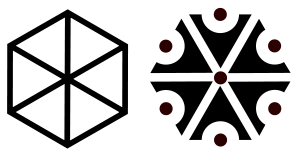
Ivanov and Toporov reconstructed the ancient myth involving the two major gods of the Proto-Slavic pantheon, Perun and Veles. The two of them stand in opposition in almost every way. Perun is a heavenly god of thunder and lightning, fiery and dry, who rules the living world from his citadel high above, located on the top of the highest branch of the World Tree. Veles is a chthonic god associated with waters, earthly and wet, lord of the underworld, who rules the realm of the dead from down in the roots of the World Tree. Perun is a giver of rain to farmers, god of war and weapons, invoked by fighters. Veles is a god of cattle, protector of shepherds, associated with magic and commerce.
A cosmic battle fought between two of them echoes the ancient Indo-European myth of a fight between a storm god and a dragon. Attacking with his lightning bolts from sky, Perun pursues his serpentine enemy Veles who slithers down over earth. Veles taunts Perun and flees, transforming himself into various animals, hiding behind trees, houses, or people. In the end, he is killed by Perun, or he flees into the water, into the underworld. This is basically the same thing; by killing Veles, Perun does not actually destroy him, but simply returns him to his place in the world of the dead. Thus the order of the world, disrupted by Veles's mischief, is established once again by Perun. The idea that storms and thunder are actually a divine battle between the supreme god and his arch-enemy was extremely important to Slavs, and continued to thrive long after Perun and Veles were replaced by God and Devil. A lightning bolt striking down a tree or burning down a peasant's house was always explained through the belief of a raging heavenly deity bashing down on his earthly, underworldly, enemy.
The enmity of the two gods was explained by Veles' theft of Perun's cattle, or by Perun's theft of Veles' cattle (since Veles was the god of cattle, the matter of ownership here is not clear). The motif of stealing divine cattle is also a common one in Indo-European mythology; the cattle in fact may be understood simply as a metaphor for heavenly water or rain. Thus, Veles steals rain water from Perun, or Perun steals water for rain from Veles (again, since Veles is associated with waters, and Perun with sky and clouds, it is unclear to whom rain should belong). An additional reason for this enmity may be wife-theft. From folklore accounts it seems that the Sun was sometimes considered to be Perun's wife (an odd idea, as all Slavic sun-gods, like Hors and Dazbog, are male). However, since the Sun, in the mythic view of the world, dies every evening, as it descends beyond the horizon and into the underworld where it spends the night, this was understood by Slavs as Veles' theft of Perun's wife (but again, the rebirth of the Sun in the morning could also be understood as Perun's theft of Veles' wife).
Jarilo and Morana
Katicic and Belaj continued down the path laid by Ivanov and Toporov and reconstructed the myth revolving around the fertility and vegetation god, Jarilo, and his sister and wife, Morana, goddess of nature and death. Jarilo is associated with the Moon and Morana is considered a daughter of the Sun. Both of them are children of Perun, born on the night of the new year (Great Night). However, on the same night, Jarilo is snatched from the cradle and taken to the underworld, where Veles raises him as his own. At the Spring festival of Jare/Jurjevo, Jarilo returns from the world of the dead (from across the sea), bringing spring from the ever-green underworld into the realm of the living. He meets his sister Morana and courts her. At the beginning of summer, the festival later known as Ivanje/Ivan, Kupala celebrated their divine wedding. The sacred union between brother and sister, children of the supreme god, brings fertility and abundance to earth, ensuring a bountiful harvest. Also, since Jarilo is a (step)son of Veles, and his wife daughter of Perun, their marriage brings peace between two great gods; in other words, it ensures there will be no storms which could damage the harvest.
After the harvest, however, Jarilo is unfaitfhul to his wife, and she vengfully slays him (returns him into the underworld), renewing the enmity between Perun and Veles. Without her husband, god of fertility and vegetation, Morana - and all of nature with her - withers and freezes in the upcoming winter; she turns into a terrible, old, and dangerous goddess of darkness and frost, and eventually dies by the end of year. The whole myth would repeat itself anew each following year, and retelling of its key parts was accompanied by major yearly festivals of the Slavic calendar. The story also shows numerous parallels to similar myths of Baltic and Hittite mythology.
Svarog, Svarogich, Dazhbog
The name of Svarog is found only in East Slavic manuscripts, where it is usually equated with the Greek smith god Hephaestus. However, the name is very ancient, indicating that Svarog was a deity of Proto-Slavic pantheon. The root svar means bright, clear, and the suffix -og denotes a place. Comparison with Vedic Svarga indicates that Svarog simply meant (daylight) sky. It is possible he was the original sky god of the pantheon, perhaps a Slavic version of Proto-Indo-European * Dyēus Ph2ter. Svarog can be also understood as meaning a shining, fiery place; a forge. This, and identification with Hephaestus from historic sources, indicates he was also a god of fire and blacksmithing. According to the interpretation by Ivanov and Toporov, Svarog had two sons: Svarogich, who represented fire on earth, and Dazhbog, who represented fire in the sky and was associated with Sun. Svarog was believed to have forged the Sun and have given it to his son Dazhbog to carry it across the sky.
In Russian manuscripts he is equated with Sun, and folklore remembers him as a benevolent deity of light and sky. Serbian folklore, however, presents a far darker picture of him; he is remembered as Dabog, a frightful and lame deity guarding the doors of the underworld, associated with mining and precious metals. Veselin Čajkanović pointed out that these two aspects fit quite nicely into a symbolism of Slavic solar deity; a benevolent side represents the Dazhbog during day, when he carries the Sun across the sky. The malevolent and ugly Dabog carries the Sun through the underworld at night. This pattern can also be applied to Sun's yearly cycle; a benevolent aspect is associated with young, summer Sun, and a malevolent one with old, winter Sun.
Svarogic was worshipped as a fire spirit by Russian peasants well after Christianisation. He was also known amongst Western Slavs, but there he was worshipped as a supreme deity in the holy city of Radegast. Svarogich is a simply diminutive of Svarog's name, and thus it may simply be another aspect (a surname, so to speak) of Dazhbog. There is also a point of view that Svarog was the ancestor of all other Slavic gods, and thus Svarogich could simply be an epithet of any other deity, so that Dazhbog, Perun, Veles, and so on, were possibly all Svarogichs.
Svantevit and Triglav
It is somewhat ironic that for now we cannot clearly determine the position of these two gods in Proto-Slavic pantheon, yet we have the most extensive historic accounts written about them. That they were important to all pagan Slavs is indicated by a significant number of toponyms whose names can be associated with them and by discoveries of multi-headed statues in various Slavic lands. Both of these gods were considered supreme in various locations; they were associated with divination and symbolized by the horse. A possibly significant difference is that Svantevit had a white horse whilst Triglav a black one, and Svantevit was represented with four heads whilst Triglav (whose name simply means Three-headed) with three. Svantevit was also associated with victory in war, harvest, and commerce.
Various hypotheses about them were proposed: that they are in fact one and the same deity, being somewhat similar; that they are not gods at all but compounds of three or four gods, a kind of mini-pantheons. Slavic neopagans tend to think of Triglav in particular as a concept of Trinity. Svantevit has also been proclaimed as a late West Slavic alternation of Perun or Jarilo, or compared with Svarogich and deemed a solar deity. None of these hypotheses is quite satisfactory, and mostly they are just wild speculation, another attempt to reconstruct Slavic mythology as it should be, rather than discovering what it was really like. Further research is necessary before more can be said of these deities.
It is claimed that Slovenian highest mountain Triglav is named after god Triglav.
Zorya and Danica
These names mean simply Dawn and Daystar, but in folklore accounts of all Slavic nations, they are often described as persons, or associated with persons, in pretty much the same way as Sun and Moon. Danica is often called Sun's younger sister or daughter, and was probably associated with Morana. Consequently, Zorya was either Sun's mother or older sister. It is quite possible this was a Slavic relic of the Proto-Indo-European dawn goddess Hausos, but further research into the matter will be necessary before more can be said of these deities.
Gods other than these cannot, at the moment, be established as Proto-Slavic deities. It should be noted, however, that it is very likely many of these gods were known by different names even in the same language. Religious taboos of using true names of deities certainly existed amongst Slavs, and thus gods were often called by additional names or adjectives, describing their qualities. Over time, these adjectives took on lives of their own.
Further developments
Ivanov and Toporov also schematically periodised various stages of development of Slavic mythology, attempting to show how it evolved from the original pantheon:
- The first subsequent development occurred after the Proto-Slavs had split into East, West, and South Slavs. Each branch of the Slavic family devised disparate deities associated with crafts, agriculture, and fertility, such as Rod and Chur, and various feminine deities of household such as Mokosh. Deities such as Hors and Simargl are sometimes interpreted as the East Slavic borrowings from their Iranian neighbours.
- At the level of abstract personification of divine functions, we have such concepts as Pravda/Krivda (Right/Wrong), Dobra Kob/Zla Kob (Good Fortune/Evil Fortune). These concepts, found in many Slavic fairy tales, are presumed to have originated at a time when old myths were already being downgraded to the level of legends and stories. Loius Leger pointed out that various Slavic words describing success, destiny, or fortune are all connected with the ancient Slavic word for God - "bog". Although used to denote the God of Christianity, the word is of pagan origin and quite ancient. It originates from the Proto-Indo-European root *bhag (meaning fortune), being cognate to Avestic baga and Sanskrit bhagah (epithets of deities).
- The next level of development is a mythologisation of historical traditions. Beginning in pagan times, it continued well after the advent of Christianity. It is characterised by tales and songs of legendary heroes, ranging from purely legendary founders of certain tribes, such as the stories about Lech, Czech, and Rus, to quite historical persons such as the 15th century Croatian-Hungarian king Matthias Corvinus or the Serbian Prince Marko, who were both immortalised in folk legend or poetry. Russian bylinas about bogatyrs, Polish legends of Krak the Dragonslayer, Czech legends about Libuše, and the foundation of Prague all fall into this category. Various elements of these tales will still reveal elements of old myths (such as a hero slaying a dragon, a faint echo of an ancient concept of a cosmic battle between Perun the Thunderer and the serpentine Veles).
- On an even lower level, certain mythical archetypes evolved into fairy-tale characters. These include Baba Yaga, Koschei the Immortal, Nightingale the Robber, Vodyanoy, Zmey Gorynych, and so on. At this point of development, one can hardly speak of mythology anymore. Rather, these are legends and stories which contain some fragments of old myths, but their structure and meaning are not so clear.
- The lowest level of development of Slavic mythology includes various groups of home or nature spirits and magical creatures, which vary greatly amongst different Slavic nations. Mythic structure on this level is practically incomprehensible, but some of the beliefs nevertheless have a great antiquity. As early as the 5th century, Procopius mentioned that Slavs worshipped river and nature spirits, and traces of such beliefs can still be recognised in the tales about vilas, vampires, witches, and werewolves.
